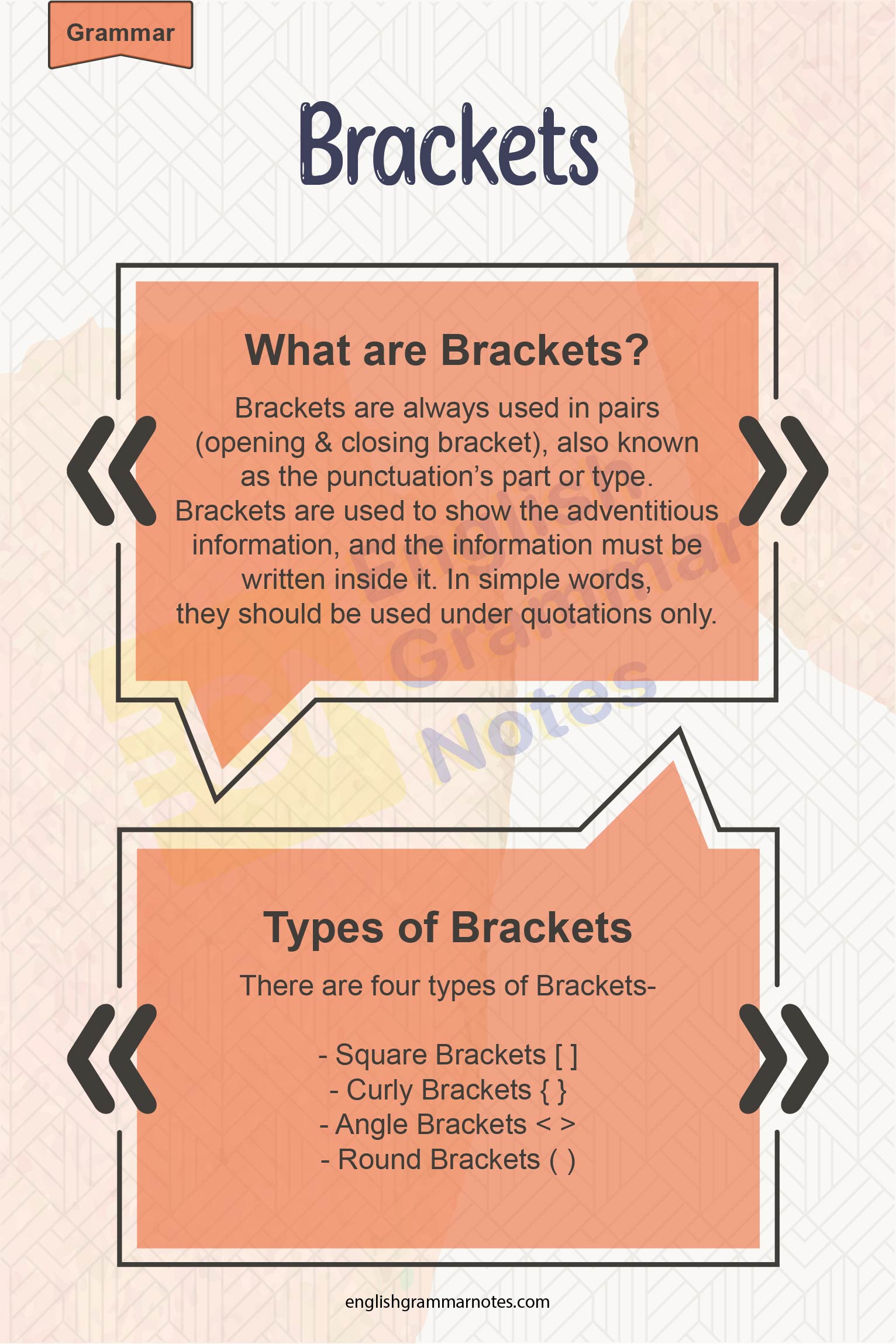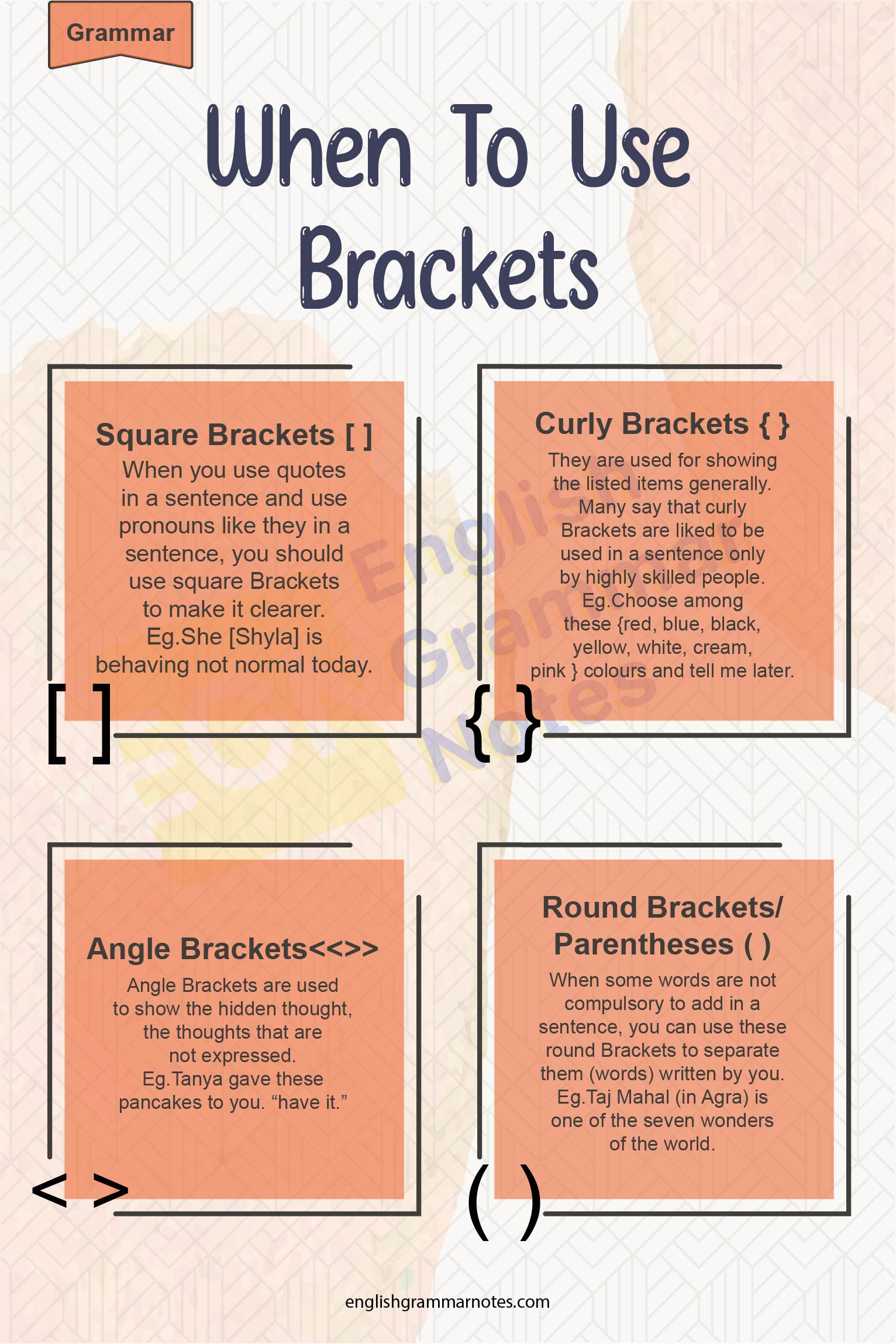Brackets: We know that there are many rules and regulations in the English language. We must follow them all, and if we don’t do this, our sentences will be completely wrong. To avoid all grammatical mistakes, we have to learn some rules in English Grammar. Brackets are one of the essential punctuations in the English language. If you want to learn how to use Brackets, keep reading our whole article, which is about ‘When to use Brackets in the English language. I hope this article will clear all your doubts related to Brackets.
Brackets in English
- What are Brackets?
- Types of Brackets
- When to use Brackets in the English language
- Final Words on Brackets
What are Brackets?
Brackets are always used in pairs (opening & closing bracket), also known as the punctuation’s part or type. Brackets are used to show the adventitious information, and the information must be written inside it. In simple words, they should be used under quotations only. Apart from that, all Brackets (aka parentheses) contain extra details inside them, and this additional detail helps one understand the sentence.
These Brackets are used to clarify the sentences or any word. We can also remove them. Removing them does not affect a sentence. So you can insert any note, explanation, comments, clarification in your own words while you quote / write any sentence. Inserting quoted material will make your sentence more effective and easy to understand to the readers.
Types of Brackets
Before knowing the uses of Brackets in the English language, we must roll our eyes to all types of Brackets.
There are four types of Brackets-
- Square Brackets [ ]
- Curly Brackets { }
- Angle Brackets < >
- Round Brackets ( )

When to use Brackets in the English Language
Square Brackets []
Square Brackets make the sentence more clear and understandable. So let’s see how to use them properly:
When you use quotes in a sentence and use pronouns like they in a sentence, you should use square Brackets to make it clearer. When you use these Brackets, the reader gets to know a few more things separately or extra. The reader understands your points very well and decides a few things on his own as well.
Let’s check some of the examples
- Anna forgave Nick Munroe for losing it [necklace].
- She [Shyla] is behaving not normal today.
As you can see in the above examples, the pronoun ‘it’has been clarified using Square Brackets with the word ‘necklace’. -[Shyla] has been inserted into the second quote by the writer to explain her identity to his visitors.
The second use of square Brackets is that they can denote the part you have skipped to quote.
Example:-
“Dr. Ramachandran is the only one I’ve seen in this area [….] with many awards, maximum 12.”
When you use square Brackets or box Brackets at the end, you should keep the period outside. This will work as final punctuation.
Examples:
- Mrs Rashad moved to New Mumbai yesterday [Radha’s home].
- Randy Johnson had come to know before that he would not see them [his missing cats].
Curly Brackets { }.
These are also known as braces. Curly Brackets are used sometimes or occasionally.
They are used for showing the listed items generally. Many say that curly Brackets are liked to be used in a sentence only by highly skilled people. People like mathematicians or English language experts can only adjust these braces in their written sentences. Apart from that, a programmer also knows how to use these Brackets well.
Over time, humans discard old things or reduce their use. In the same way, these Brackets are used by very few people. They are used in a sentence to show the same choices,
Let’s see the examples below.
- Choose among these {red, blue, black, yellow, white, cream, pink } colours and tell me later.
- Select any of our employees { Edward, Jonas, Emily, Molly, Shyla Parton, Kristen Jones, Robert Smith, Ketty Barbara} for this project because it’s an important project.
- I met Daniel’s friends { Baron, Stewart, Mitchell and ricco} today. They were amazing people.
- Your hobbies {playing chess, playing instruments, driving a car, playing cricket}, can you tell me now?
As you can see, in these four above mentioned examples, everything is well explained inside the curly Brackets. The whole list is contained inside this bracket so that the reader may understand well who he wants to meet or what colour clothes he wants to buy.
Let’s see another example of curly Brackets.
Roy: hey, darling, be ready for dinner date ok, I’m coming home with your favourite golden ring
({)RihannaMotherof2:Darling..aww..thanks…..honey(})
Angle Brackets<<>>
The other names of angle Brackets are
chevrons, diamond Brackets, left and right carrot and pointy Brackets. You must have noticed these Brackets in mathematics and physics mostly.
Angle Brackets are used to show the hidden thought, the thoughts that are not expressed.
For example:
- Tanya gave these pancakes to you. “have it.”
I ate that pancake immediately. “hmm… delicious.” <I didn’t like that much>
The second use of these angle Brackets is that they are also used in comic books when a character of that comic book speaks its dialogues in another language.
They are used in place of quotation marks as well. Not every time, but sometimes it can be used properly.
In computers, they are used to show status and action.
For example:
<<online>>
< <Blow>>
<<off>>
<<On>>
<<Off/On>>
<< Shut down>>
Round Brackets/Parentheses ( )
Round Brackets, or you can say parentheses(American English), has many uses in our daily writing work, isn’t it?. These Brackets don’t affect your written sentences if you remove them but will make your sentences more perfect.
When some words are not compulsory to add in a sentence, you can use these round Brackets to separate them (words) written by you. This will not change the meaning of your sentence but will make your sentence short and effective.
Examples:
- Taj Mahal (in Agra) is one of the seven wonders of the world.
- Denali (South Central Alaska) is the tallest mountain in North America.
- I want to see Denali ( also known as Mount McKinley) mountain.
- Anna James (manager of this hotel) is a very sensible and skilled lady.
- There are a variety of pizzas available in my restaurant (Have which one likes)
- He framed the word “Měilì de” (from the Chinese word Měilì demeaning “beautiful”) and pronounced it continuously.
For showing an abbreviation in any sentences
Examples-
- Measure this cloth (cm).
- Affective Disorder (SAD) is a dangerous disorder.
For adding any comment, round Brackets are used by the writer.
Example-
- Wow, beautiful!! (I’m talking about your dress!).
- They are not good humans (trust me).
For showing any alternative information
Examples-
No more time has been left for us to get out of here(only 10 minutes!).
You don’t have much time left to finish your Christmas shopping (only six shopping days!).
- Buy a pink one, Bella (or black one).
- Shut up! (you have spoken much).
Punctuating Brackets – Rules
After knowing all the ways of using different Brackets in English, now also read the rules for punctuating these four (Curly Brackets, Angle Brackets, Round Brackets) Brackets so that you may use them correctly without facing any issue.
Rules for punctuating Brackets are as flooding:-
Rule no.1
The whole matter/sentence should be written inside Brackets, and the same goes with the full stop. So place periods inside if the written sentence is not parenthetical.
See the example:-
(This rule should be followed when you are writing the whole sentence.)
Rule no.2
When a written sentence is just a part of the whole sentence, then go with rule number2.
Examples:-
- She is lovely (and awesome too).
- Are you coming to my Christmas party? (or not).
Rule no.3
When the clause is finished, close the bracket and put a comma outside it.
Examples:-
- Shyla, start packing your bags today for our long trips (10 days) so that you don’t have to work too much later.
- We will buy a car tomorrow (Wednesday), so tell me which colour you like, honey.
Rule no.4
When a question mark or exclamation mark comes in a sentence, put them after completing the sentence. Later, put a period/full stop after you close the bracket. That was the fourth and last rule for punctuating Brackets.
Examples:-
- Emma Johnson and Eddie Johnson were not invited (and they were utterly furious!).
- (I like that/this!).
- I liked those new Mercedes (really, that is awesome!).
- She is mad (isn’t she?).

Final Words on Brackets
I hope you must have understood by now ‘how to use Brackets in English language’ & When to use Brackets in English.Well, it’s confirmed that If one does not know the rules related to Brackets in English Grammar, many mistakes can happen.
Often we make such mistakes while writing sentences in English. So it’s just for everyone to know the proper use of these Brackets for avoiding such errors in the English language.
You are free to encounter these four Brackets mentioned above for making your sentence more effective and easy to understand. So, we saw how necessary Brackets are and how they clear writers’ views and thoughts. They show one’s comments, wishes, inside hidden thoughts, foreign language meanings /translations and many more like this. I hope our article helped you a lot in knowing the rules of using these Brackets. Thank you!